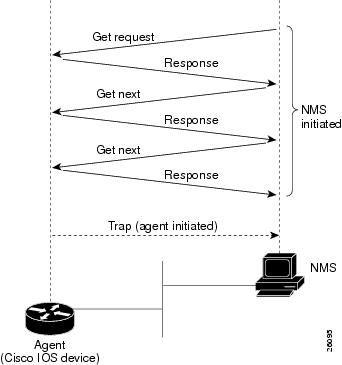Simple Network Management Protocol (SNMP) is an "Internet-standard protocol for managing devices on IP networks." Devices that typically support SNMP include routers, switches, servers, workstations, printers, modem racks, and more."[1] It is used mostly in network management systems to monitor network-attached devices for conditions that warrant administrative attention. SNMP is a component of the Internet Protocol Suite as defined by the Internet Engineering Task Force (IETF). It consists of a set ofstandards for network management, including an application layer protocol, a database schema, and a set of data objects.[2]
SNMP exposes management data in the form of variables on the managed systems, which describe the system configuration. These variables can then be queried (and sometimes set) by managing applications.
Overview and basic concepts
In typical SNMP uses, one or more administrative computers, called managers, have the task of monitoring or managing a group of hosts or devices on a computer network. Each managed system executes, at all times, a software component called an agent which reports information via SNMP to the manager.
Essentially, SNMP agents expose management data on the managed systems as variables. The protocol also permits active management tasks, such as modifying and applying a new configuration through remote modification of these variables. The variables accessible via SNMP are organized in hierarchies. These hierarchies, and other metadata (such as type and description of the variable), are described by Management Information Bases (MIBs).
An SNMP-managed network consists of three key components:
- Managed device
- Agent — software which runs on managed devices
- Network management system (NMS) — software which runs on the manager
A managed device is a network node that implements an SNMP interface that allows unidirectional (read-only) or bidirectional access to node-specific information. Managed devices exchange node-specific information with the NMSs. Sometimes called network elements, the managed devices can be any type of device, including, but not limited to, routers,access servers, switches, bridges, hubs, IP telephones, IP video cameras, computer hosts, and printers.
An agent is a network-management software module that resides on a managed device. An agent has local knowledge of management information and translates that information to or from an SNMP specific form.
A network management system (NMS) executes applications that monitor and control managed devices. NMSs provide the bulk of the processing and memory resources required for network management. One or more NMSs may exist on any managed network.
About Basic SNMP Message Types and Commands
There are three basic SNMP message types:
• Get—NMS-initiated requests used by an NMS to monitor managed devices. The NMS examines different variables that are maintained by managed devices.
Get—NMS-initiated requests used by an NMS to monitor managed devices. The NMS examines different variables that are maintained by managed devices.
• Set—NMS-initiated commands used by an NMS to control managed devices. The NMS changes the values of variables stored within managed devices.
Set—NMS-initiated commands used by an NMS to control managed devices. The NMS changes the values of variables stored within managed devices.
• Trap—Agent-initiated messages sent from a managed device, which reports events to the NMS.
Trap—Agent-initiated messages sent from a managed device, which reports events to the NMS.
The Cisco IOS generates SNMP traps for many distinct network conditions. Through SNMP traps, the Network Operations Center (NOC) is notified of network events, such as:
– Link up/down changes
Link up/down changes
– Configuration changes
Configuration changes
– Temperature thresholds
Temperature thresholds
– CPU overloads
CPU overloads

Note  For a list of Cisco-supported SNMP traps, go to http://www.cisco.com/public/mibs/traps/
For a list of Cisco-supported SNMP traps, go to http://www.cisco.com/public/mibs/traps/
Figure 2

SNMP Event Interactions Between the NMS and the Agent
資料來源: http://en.wikipedia.org/wiki/Simple_Network_Management_Protocol
http://www.cisco.com/en/US/docs/ios/internetwrk_solutions_guides/splob/guides/dial/dial_nms/snmpover.html
http://www.cisco.com/en/US/docs/ios/internetwrk_solutions_guides/splob/guides/dial/dial_nms/snmpover.html
沒有留言:
張貼留言